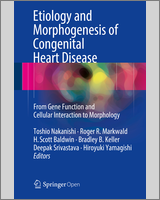While the critical pathways that are important for normal cardiac development have focused extensively on transcriptional regulation of myocyte differentiation, critical mediators of vascular development have received much less attention. One reason for this has been the inability in the past to manipulate gene expression in a temporal and tissue-specific manner. There is no doubt that both normal vascular and normal myocardial development are essential for early embryonic survival and the two are inextricably linked; normal vascular development requires normal flow, and maturation of the myocardium requires simultaneous maturation and remodeling of the extracardiac vasculature. Ubiquitous or global gene deletions, resulting in both cardiac and extracardiac mutations, have resulted in numerous “chicken and egg” quandaries: Did the heart fail because of a primary defect in heart development, or were the defects merely secondary to upstream perturbations in extracardiac vascular defects? In this section, investigators used tissue-specific mutagenesis strategies as well as a focus on cell membrane and extracellular matrix regulation to begin to elucidate important aspects of extracardiac vascular development that are particularly relevant to human disease. Sakebe et al. generated an endothelial-specific deletion of Hrt2/Hey2, repressors of Notch signaling, to demonstrate that both Hrt1 and Hrt2 are essential for vascular development independent of their role in myocardial development. Furthermore, they suggest that the endothelial or vascular processes mediated by these factors, rather than the defects in myocardial development, might be the primary mechanism for embryonic demise. Exploring the role of calcium signaling in extraembryonic vascular development, Uchida and colleagues were able to document dramatic defects in placentation as early as E9.5 in the mouse as a result of combinatorial deletion of the inositol IP3 receptors. This work clearly establishes a role for calcium handling in cardiovascular viability. Changing the focus to later stages of vascular development, Dr. Imanaka-Yoshida provides a detailed description of the role of the extracellular matrix protein, tenascin-C, in smooth muscle cell recruitment of both the descending aorta and coronary arteries and provides in vitro evidence that tenascin-C promotes SMC precursor expansion and differentiation by augmenting PDG-BB/PDGFR-β signaling. Finally, Yoshikane et al. show the potential importance of delineating the role of tenascin-C in normal and abnormal coronary artery remodeling as they discuss a model of the most common acute systemic vasculitis in children, Kawasaki disease. By studying the inflammatory and abnormal vascular remodeling induced by Candida albicans, they demonstrate accentuation of tenascin-C expression associated with aneurysm formation. Furthermore, they document that inhibition of JNK signaling attenuated aneurysm formation potentially providing a mechanistic link between JNK signaling and tenascin-C signaling that could provide a therapeutic target for treatment of Kawasaki disease. In summary, the investigations presented in this section provide an overview of exciting work that expands the focus of cardiovascular development and disease beyond myocyte transcriptional regulation and provides new insights into extracardiac vascular development and remodeling while emphasizing the importance that the extracellular matrix is ontogeny of cardiovascular disease.

